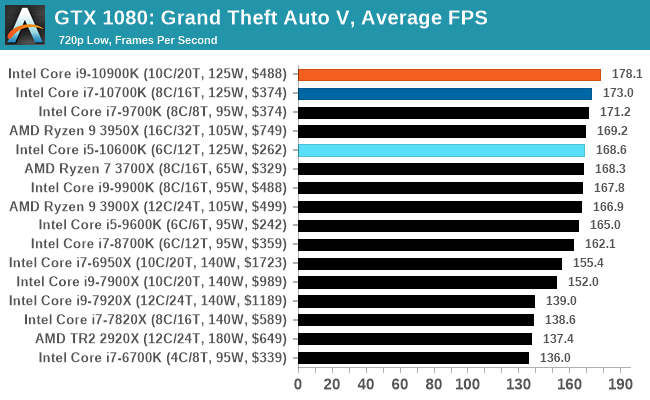The Intel Comet Lake Core i9-10900K, i7-10700K, i5-10600K CPU Review: Skylake We Go Again
by Dr. Ian Cutress on May 20, 2020 9:00 AM EST- Posted in
- CPUs
- Intel
- Skylake
- 14nm
- Z490
- 10th Gen Core
- Comet Lake
Gaming: Grand Theft Auto V
The highly anticipated iteration of the Grand Theft Auto franchise hit the shelves on April 14th 2015, with both AMD and NVIDIA in tow to help optimize the title. GTA doesn’t provide graphical presets, but opens up the options to users and extends the boundaries by pushing even the hardest systems to the limit using Rockstar’s Advanced Game Engine under DirectX 11. Whether the user is flying high in the mountains with long draw distances or dealing with assorted trash in the city, when cranked up to maximum it creates stunning visuals but hard work for both the CPU and the GPU.
For our test we have scripted a version of the in-game benchmark. The in-game benchmark consists of five scenarios: four short panning shots with varying lighting and weather effects, and a fifth action sequence that lasts around 90 seconds. We use only the final part of the benchmark, which combines a flight scene in a jet followed by an inner city drive-by through several intersections followed by ramming a tanker that explodes, causing other cars to explode as well. This is a mix of distance rendering followed by a detailed near-rendering action sequence, and the title thankfully spits out frame time data.
There are no presets for the graphics options on GTA, allowing the user to adjust options such as population density and distance scaling on sliders, but others such as texture/shadow/shader/water quality from Low to Very High. Other options include MSAA, soft shadows, post effects, shadow resolution and extended draw distance options. There is a handy option at the top which shows how much video memory the options are expected to consume, with obvious repercussions if a user requests more video memory than is present on the card (although there’s no obvious indication if you have a low end GPU with lots of GPU memory, like an R7 240 4GB).
All of our benchmark results can also be found in our benchmark engine, Bench.

| AnandTech | IGP | Low |
| Average FPS |  |
 |
| 95th Percentile |  |
 |











220 Comments
View All Comments
UltraWide - Wednesday, May 20, 2020 - link
Intel's 10th gen is a hard pass for me.I'll wait patiently with my 4770K.
Spunjji - Tuesday, May 26, 2020 - link
Haswell was the last time I remember being excited about an Intel CPU.AnarchoPrimitiv - Wednesday, May 20, 2020 - link
Why is the article stating that the 10900k is "around the same price" as the 3900x when its literally around $100 more (3900x currently goes for $417 and the 10900k has listed at $522, $488 is only the tray price when you buy 1000 or more CPUs)? In my opinion a 25% more expensive CPU isn't "around the same price"dirkdigles - Wednesday, May 20, 2020 - link
Same thoughts - I commented on that earlier. Quite misleading IMO.drothgery - Wednesday, May 20, 2020 - link
comparing retail prices of something just released vs something that's been out for months is silly, so they went by MSRP (which for CPUs is the tray price)?GreenReaper - Wednesday, May 20, 2020 - link
Don't see how that works. You buy based on the performance available now, that is what the charts are based on - so why not the price now?duploxxx - Wednesday, May 20, 2020 - link
perhaps a reviews site should start testing with the defaults…. so put a default cooler on this system and test again in a case and heating next to it and see how much is reall left from this marketing turbo and theoretical benchmarking....jameslr - Wednesday, May 20, 2020 - link
What's a "default cooler"? None of these CPUs come with a "cooler" or HSF unit.GreenReaper - Wednesday, May 20, 2020 - link
So test it anyway, see what happens when you don't include a vital bit of kit in the comparison price.Spunjji - Tuesday, May 26, 2020 - link
The AMD ones do. They could throw in a known-equivalent cooler on the Intel side and repeat a few of the tests with it to see how it fares - one of those $30 Coolermaster jobs should do the trick.At least that way you'd get an idea of the extremes - "properly" cooled with a water loop vs. cooled the way most people used to do home builds.